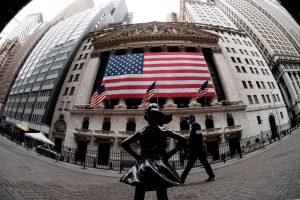SEPTEMBER 20, 2021

The fearless girl statue and the New York Stock Exchange (NYSE) are pictured on April 20, 2020 at Wall Street in New York City. – Wall Street opened lower on Monday as traders grappled with a drop in oil prices to 22-year lows as the coronavirus pandemic sapped demand for energy. – JOHANNES EISELE, AFP via Getty Images
Stocks slumped on Monday, sending the Dow Jones industrial average to its biggest drop in months on worries that one of China’s largest property developers could default on billions of debt, which could threaten to spill over into other parts of the global economy.
The blue-chip index shed 614 points, or 1.8%, to 33,970.47, its worst sell-off since July.
The S&P 500, the benchmark used for most mutual funds, fell 1.7%, its biggest decline since May. The benchmark index hasn’t posted a decline of more than 1% since mid-August. It’s also coming off two weeks of losses and is on track for its first monthly decline since January.
Technology companies led the broader market lower, with the Nasdaq falling 2.2%. Apple dropped 2% and chipmaker Nvidia shed 3.6%.
A number of factors have weighed on investors in recent weeks. Worries about debt-engorged Chinese property developers — and the damage they could do to investors worldwide if they default — rippled across global markets on Monday.
The worries have recently centered on Evergrande, one of China’s biggest real estate developers, which looks like it may be unable to repay its debts.
Investors, meanwhile, are also concerned that the Federal Reserve could signal this week that it’s planning to pull back some of the support measures it’s provided markets and the economy. The Fed is due to deliver its latest economic and interest rate policy update on Wednesday.
To be sure, the stock market has remained resilient despite concerns about the economic effects of the spread of the Delta coronavirus variant and worries about the Fed’s plans. The S&P 500 has rallied more than 90% since the pandemic-fueled sell-off in March 2020.
The fear over Evergrande is that a potential collapse there could send a chain reaction through the Chinese property-development industry and spill over into the broader financial system, similar to how the failure of Lehman Brothers inflamed the 2008 financial crisis and Great Recession. Those property companies have been big drivers of the Chinese economy, which is the world’s second-largest.
If they fail to make good on their debts, the heavy losses taken by investors who hold their bonds would raise worries about their financial strength. Those bondholders could also be forced to sell other, unrelated investments to raise cash, which could hurt prices in seemingly unrelated markets. It’s a product of how tightly connected global markets have become, and it’s a concept the financial world calls “contagion.”
Many analysts say they expect China’s government to prevent such a scenario, and that this does not look like a Lehman-type moment. Nevertheless, any hint of uncertainty may be enough to upset Wall Street after the S&P 500 has glided higher in an almost uninterrupted fashion since October.
“The unwinding of Evergrande will be sloppy and cause disruptions, but we expect the Chinese government will manage this default,” Keith Lerner, co-chief investment officer and chief market strategist at Truist, said in a note to clients.
The Evergrande situation wasn’t the primary reason for Monday’s selloff, according to Jamie Cox, managing partner at Harris Financial Group, an investment and financial planning firm.
Besides Evergrande, several other worries have been lurking underneath the stock market’s mostly calm surface. In addition to the Fed possibly announcing that it’s easing its its support for the economy, Congress may opt for a destructive game of chicken before allowing the U.S. Treasury to borrow more money and the COVID-19 pandemic continues to weigh on the global economy.
“Stalemates in Congress on the debt ceiling, worries on policy changes or mistakes in monetary policy and a litany of proposed tax increases have dampened the mood for investors,” Cox said in a note. “When this occurs, corrections happen.”
September is also historically the weakest month of the year in the stock market, averaging a 0.4% decline, according to the Stock Trader’s Almanac.
Regardless of what the biggest cause for Monday’s market swoon was, some analysts said such a decline was due. The S&P 500 hasn’t had a 5% drop from a peak since October, and the nearly unstoppable rise has left stocks looking more expensive and with less room for error.
The stock market typically sees about three 5%-plus falls a year on average. That makes the market more vulnerable in the near term following some signs of investor complacency, analysts say. Monday’s decline pushed the S&P 500 nearly 5% below its record high set on Sept. 2. Both the Dow and the Nasdaq were also more than 5% from their all-time highs.
The S&P 500 has only had two other years since 1980 where it didn’t see at least one intra-year pullback of more than 5%, Lerner said. The deepest pullback this year prior to Monday was just 4%, he added.
Elsewhere, the Hang Seng, Hong Kong’s main index, dropped 3.3% for its biggest loss since July. Many other markets in Asia were closed for holidays. European markets fell about 2%.










































































































